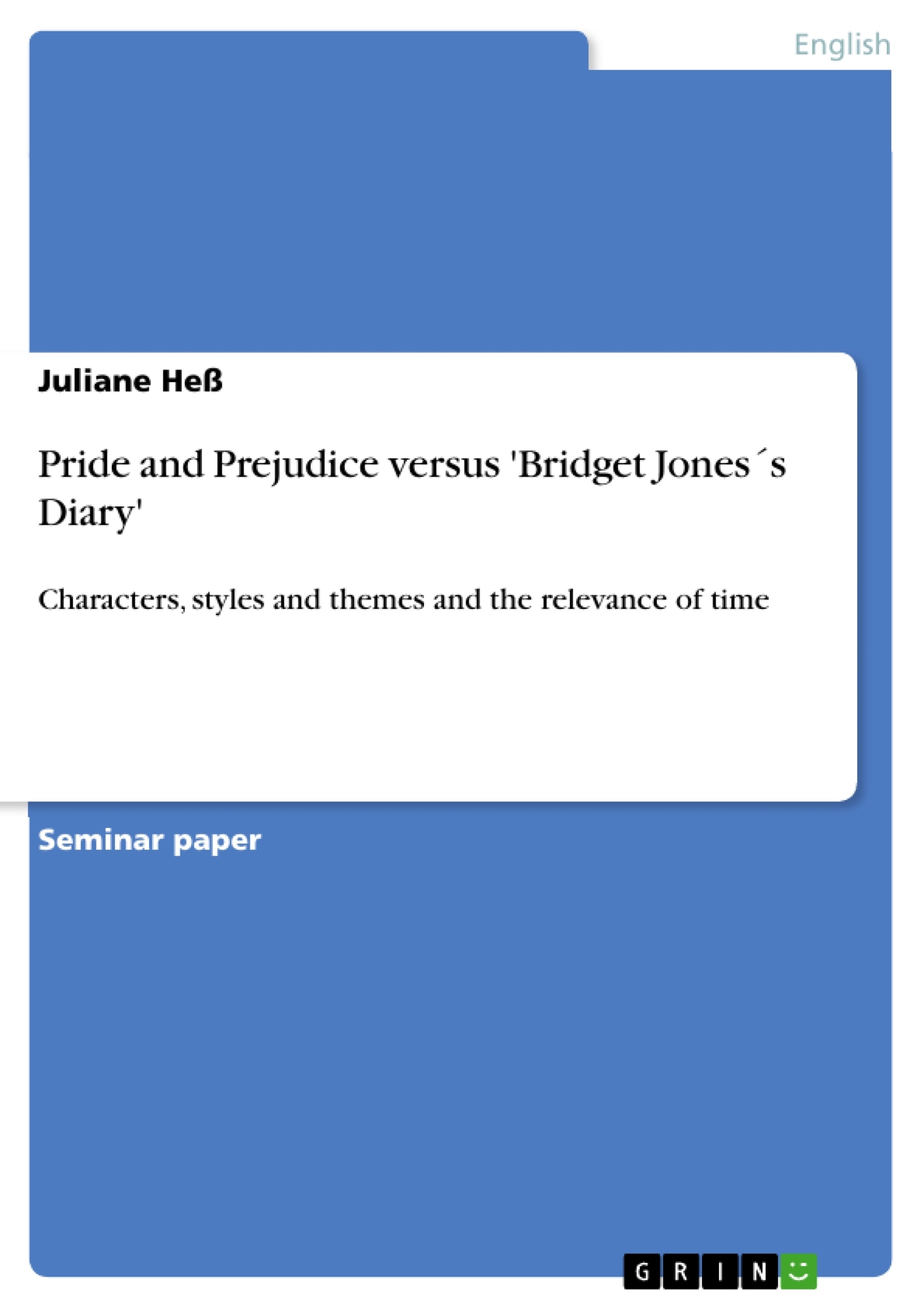Bridget Jones is a chain-smoker and a hard-drinker. She is messy, slightly overweight and, even worse, she is still single. Clumsy Bridget spends her time downing drinks with her crazy single friends and strolling around the office with her little skirt. Helen Fielding´s modern novel opens the diary of a British single woman who is desperately looking for “Mr. Right” in a world of “emotional fuckwittages”. Quite the contrary is Elizabeth Bennet, the young heroine in Jane Austen´s most famous novel Pride and Prejudice. She is one of 5 daughters, polite, sophisticated, selfless and, due to her education, she would never compromise herself in public like Bridget always does.
One can hardly believe that there can be found any parallels between Bridget Jones´s Diary and the probably most romantic British novel, Pride and Prejudice. In fact, there are about 200 years between both works but they are indeed comparable...
Table of Contents
- Introduction
- The stolen Story: Characters and the Plot
- Heroes and their Antagonists: The Presentation of Men
- Darcy The Hero
- Cleaver and Wickham - The Bastards
- Elizabeth Jones meets Bridget Bennet
- Fine Eyes and Size 12
- The Lack of Education
- Self-confidence meets Clumsiness
- The Role of the Family
- Different Time, Different Style
- Narrative Mode
- Language
- The Change of the Novel: From Metaphors of Love to cheeky Chicklit
- The Importance of Coupledom and Marriage
- Spinsters, Bachelors, Singletons and Social Pressure
- Men are from Mars, Women are from Venus
- Marriage - Material in the 19th and 20th Century
- Superficiality - The Importance of Beauty
- Spinsters, Bachelors, Singletons and Social Pressure
- Bridget Jones - A top Post-Modernist and a Post-Feminist
Objectives and Key Themes
This term paper aims to compare and contrast the characters, styles, and themes of Jane Austen's *Pride and Prejudice* and Helen Fielding's *Bridget Jones's Diary*, highlighting the relevance of both novels across time. The paper examines how the works reflect social changes, particularly in the role of women, and explores the enduring appeal of classic romantic archetypes.
- The evolution of female characters in literature
- The timeless appeal of romantic archetypes, particularly the "hero" figure
- The influence of social context on literary style and themes
- The enduring power of misunderstanding, pride, and prejudice in romantic relationships
- The role of family dynamics and societal pressures in shaping individual choices
Chapter Summaries
The introduction sets the stage for the comparison by establishing the initial parallels and differences between *Pride and Prejudice* and *Bridget Jones's Diary*. It highlights the enduring relevance of Austen's themes and characters, as well as the way Fielding's novel serves as a modern adaptation.
Chapter 2 delves into the "stolen story," examining the similarities in plot and character development between the two novels. It emphasizes the "party" setting, the initial misjudgments of the protagonists, and the recurring motif of pride and prejudice as obstacles to love.
Chapter 3 focuses on the presentation of male characters, specifically the "hero" and the "bastards" in both novels. It analyzes the enduring appeal of the Darcy figure, highlighting the similarities between Mr. Darcy and Mark Darcy, and explores how the heroine's portrayal reflects changing social contexts.
Chapter 4 compares Elizabeth Bennet and Bridget Jones, contrasting their personalities, social situations, and self-confidence. It examines how these characters embody different ideals of womanhood across time.
Chapter 5 explores the role of the family in both novels, focusing on the pressures and dynamics within the Bennet and Jones families.
Chapter 6 delves into the stylistic differences between the two works, exploring how the narrative mode, language, and overall tone reflect the changing literary landscape and social norms.
Keywords
Key themes and concepts explored in this paper include: Pride and Prejudice, Bridget Jones's Diary, Jane Austen, Helen Fielding, romantic archetypes, social context, female characters, literary style, narrative mode, marriage, family dynamics, societal pressures, misunderstandings, and the evolution of literature.
- Quote paper
- Juliane Heß (Author), 2010, Pride and Prejudice versus 'Bridget Jones´s Diary', Munich, GRIN Verlag, https://www.grin.com/document/177677




